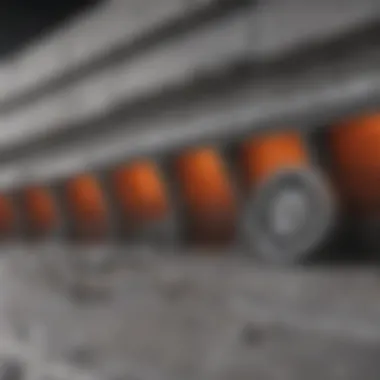Exploring Fiberglass Concrete Reinforcement Benefits


Intro
Fiberglass concrete reinforcment is a topic that’s gathering steam in modern construction circles. This innovative solution is not just another trend; it stands as a testament to the evolving nature of structural engineering. Its inclusions transform the conventional ways we look at concrete, and with the rising demand for durable and resilient materials, fiberglass presents itself as a formidable alternative to traditional steel reinforcement.
The properties of fiberglass, combined with concrete, give birth to a composite material that is light yet robust. As we venture into this exploration, we'll look beyond the surface. The interplay between fiberglass and concrete offers insights into how we can reshape infrastructures, ensuring longevity and sustainability. From bridges holding up under colossal loads to flooring resistant to cracking, understanding fiberglass as a reinforcing agent is paramount.
What makes this topic particularly significant is its real-world applications. Engineers and architects across the globe are employing fiberglass technologies to tackle challenges that conventional methods might struggle to overcome. As we dig deeper, this article will articulate several critical aspects: the underlying composition of fiberglass, its properties when mixed with concrete, various case studies showcasing its capabilities, and a comparative analysis with steel reinforcement. The aim here is to not just elucidate but to inspire further inquiry into this fascinating subject.
Understanding Fiberglass Reinforcement
The topic of fiberglass reinforcement is crucial because it answers the fundamental question of how we can improve the integrity of concrete structures while simultaneously addressing sustainability concerns. As urban environments burgeon and the demand for resilient infrastructure intensifies, polymer-based composites, particularly fiberglass, become increasingly relevant. These materials not only fulfill the traditional roles of reinforcement but also bring along a suite of attributes that conventional methods lack.
Definition and Composition
Fiberglass reinforcement refers to the inclusion of fiberglass reinforcements into concrete mixes to enhance their strength, durability, and overall performance. At its core, fiberglass is made from extremely fine fibers of glass and can come in various forms, contributing to varied mechanical properties when mixed with concrete. The elementary composition of fiberglass consists of a polymer matrix, typically thermoset or thermoplastic, which encapsulates the glass fibers. This composite structure is what allows for improved properties—such as tensile strength and resistance to environmental factors—that standard concrete alone is unable to achieve.
Types of Fiberglass Materials
Specific types of fiberglass materials play unique roles in the context of concrete reinforcement.
Glass Fiber
Glass fiber is renowned for its tensile strength, which makes it a particularly appealing choice for reinforcing concrete. One key characteristic of glass fiber is its excellent bonding with concrete, leading to a composite that exhibits cohesive strength. This type of reinforcement is commonly used in applications such as cladding panels and precast products.
A unique feature of glass fiber is its affordability compared to other materials. However, it's worth noting that its susceptibility to UV degradation may limit its application in direct sunlight for prolonged periods of time.
Carbon Fiber
In the world of fiberglass materials, carbon fiber stands out due to its exceptional strength-to-weight ratio. It can significantly enhance concrete structures without adding much weight, making it a popular choice in projects where load considerations are critical. One of its remarkable attributes is its minimal thermal expansion, which ensures dimensional stability in fluctuating temperatures.
However, carbon fiber is often more expensive, which can be a sticking point for some projects. Still, its long-term performance gains usually justify the initial higher cost.
Aramid Fiber
Aramid fiber, though less common than its glass or carbon counterparts, holds substantial potential for concrete reinforcement. Its strength is comparable to that of steel, and it remains flexible, allowing for excellent energy absorption in impacts. This makes aramid fiber especially valuable in applications exposed to dynamic loading conditions.
One standout feature of aramid fiber is its resistance to changes in temperature and humidity. Conversely, it's important to acknowledge that aramid fibers can be less chemically resistant than other types of fibers, which could restrict their use in certain environments.
In summary, understanding fiberglass reinforcement is about more than just materials; it's about leveraging these advanced composites to maximize performance and longevity in concrete applications. The continued evolution and refinement of these materials represent not just a shift in construction practices, but also a deeper understanding of the materials we use in the fight against time and elements.
Concrete Reinforcement: A Historical Perspective
Understanding the historical evolution of concrete reinforcement is crucial, as it provides context for the advancements we see today, particularly with fiberglass solutions. Traditional reinforcement methods laid the groundwork for structural integrity in construction, but they revealed limitations that fiberglass began to address. Over time, the construction industry has recognized the value of new materials, and the shift from conventional methods to fiberglass has marked a significant technological leap forward.
Traditional Methods of Reinforcement
Steel Reinforcement
The backbone of traditional concrete reinforcement has been steel, primarily due to its strength and durability. Steel bars, commonly known as rebar, are incorporated into concrete to counteract tensile stresses. This material offers exceptional load-bearing capabilities, making it highly popular among engineers and construction professionals. One of the key characteristics of steel reinforcement is its relatively low cost compared to other materials, allowing for widespread use in construction projects.
Honestly, steel has its own share of drawbacks. One major concern is its susceptibility to corrosion, particularly in environments exposed to water or chemicals. This could lead to structural failure if not properly addressed. Nevertheless, its ease of integration with concrete has kept it in high regard.
Here are some of the advantages of steel reinforcement:
- High tensile strength.
- Cost-effectiveness in construction.
- Widely available and recognized by building codes.
However, some disadvantages must be acknowledged as well:
- Prone to corrosion under certain conditions.
- Heavier than alternative reinforcement materials, making handling and installation cumbersome.
Wire Mesh Systems
Another staple in traditional methods of concrete reinforcement is wire mesh systems. These configurations involve grids of intersecting wire, often made of steel, that provide localized reinforcement within concrete slabs and walls. The primary advantage of wire mesh is its ability to distribute stresses evenly and reduce cracking as concrete shrinks during the curing process.


Despite its benefits, wire mesh systems have limitations. They tend to be less effective in applications requiring high tensile strength compared to rebar. Their installation also requires careful machining, and if not done properly, they can fail to deliver expected results.
Key characteristics of wire mesh systems include:
- Flexibility in design and application.
- Capability to easily conform to curved surfaces.
Yet, there are disadvantages to keep in mind:
- Inadequate tensile support compared to solid steel bars.
- Complicated installation procedures may increase labor costs.
Evolution to Fiberglass Solutions
The transition to fiberglass solutions has brought along remarkable innovations in concrete reinforcement. As traditional methods struggled with issues like corrosion and weight, fiberglass emerged as a formidable alternative. This evolution isn't merely about swapping one material for another; it's about enhancing structural performance and longevity in construction. Fiberglass offers unique properties that reduce susceptibility to environmental conditions, making it a long-lasting choice.
Fiberglass reinforcement also represents a shift toward more sustainable construction practices. The close examination of historic reinforcement methods reveals gaps that modern technology aims to fill. A growing awareness of the limitations of steel and wire mesh systems has facilitated this transition, making fiberglass a significant player in the reinforcement game, steering the industry toward a more resilient future.
"The evolution from traditional materials to fiberglass underscores the construction industry's commitment to innovation and resilience."
This historical perspective illustrates that the quest for improvement in concrete reinforcement is an ongoing journey, pointing toward a future where fiberglass could redefine strength and sustainability.
Benefits of Fiberglass Reinforcement in Concrete
Understanding the various benefits associated with fiberglass reinforcement in concrete is essential for anyone involved in construction, engineering, or material science. Fiberglass, with its unique properties, offers significant advantages over traditional materials. This exploration dives into three pivotal areas: its improved strength-to-weight ratio, corrosion resistance, and durability.
Improved Strength-to-Weight Ratio
Fiberglass reinforcement showcases an impressive strength-to-weight ratio, which makes it a compelling choice for various applications. This is vital, especially in scenarios where minimizing weight without sacrificing strength is paramount. In layman's terms, you get a robust material without the added heft of steel or other metals.
- Application in Structures: Fiberglass can be ideal in designs such as bridges or commercial buildings, where every pound counts. Less weight means easier handling and installation, potentially reducing labor costs and complexities in logistics.
- Performance Insights: Research indicates that fiberglass can provide strength that meets or exceeds that of steel while being significantly lighter. This leads to a lower overall structural load, essential for sustainability and safety considerations in engineering.
"In today’s construction climate, being lightweight is not just a bonus; it's an absolute necessity for modern design."
Corrosion Resistance
One of the standout features of fiberglass reinforcement is its inherent resistance to corrosion. In environments where moisture and chemicals abound, traditional steel reinforcement can falter, leading to structural failures.
- Longevity in Harsh Conditions: Using fiberglass eliminates many worries related to rust and chemical degradation, especially in areas like coastal regions or industrial setups.
- Cost Efficiency: Since fiberglass does not corrode, maintenance costs can take a nosedive. This translates into savings over the lifespan of a structure, making fiberglass not only a smart engineering choice but also a financially savvy one.
Enhanced Durability and Longevity
Durability is often seen as the backbone of any construction material, and fiberglass doesn’t disappoint in this aspect. The composition of fiberglass enables it to withstand significant stress, environmental factors, and wear and tear, ensuring that structures remain intact for longer periods.
- Real-World Examples: Projects in severe environmental conditions, like water treatment plants or offshore structures, have utilized fiberglass reinforcement to excellent effect. Its capability to handle harsh climates makes it an ideal candidate for diverse construction needs.
- Future-Proofing: As more research supports the benefits of durability in fiberglass applications, this material seems poised to pave the way for future developments in reinforcing technology.
Applications of Fiberglass Concrete Reinforcement
The implementation of fiberglass in concrete reinforcement is significant, encompassing a vast array of applications across various sectors. This material offers unique benefits, such as lighter weight, greater corrosion resistance, and improved durability compared to traditional methods. The versatility of fiberglass makes it an attractive option for multiple construction projects, greatly enhancing structural integrity while reducing weight. By examining specific applications, we can understand how fiberglass concrete reinforcement is shaping modern construction techniques.
Infrastructure Projects
Bridges
Bridges represent a quintessential application of fiberglass-concrete reinforcement. The key characteristic that makes fiberglass a compelling choice for bridge construction is its ability to resist environmental degradation, a common pitfall with steel reinforcement. The durability of fiberglass composites ensures that materials will stand the test of time under varying conditions such as moisture and temperature fluctuations.
One unique feature of fiberglass in bridges is its lightweight nature, which can significantly reduce the overall load on bridge support structures. This not only aids in construction but can also result in lower maintenance costs over the long term. The longevity and efficiency of fiberglass reinforcement promote safer transport routes, a crucial factor in urban planning and infrastructure development.
Tunnels
Tunnels, much like bridges, benefit greatly from utilizing fiberglass reinforcement. The specific aspect of tunnels lies in their unique structural requirements, often involving significant loads from earth above and potential moisture infiltration. One key characteristic of fiberglass in tunnel construction is its resistance to corrosion. This is particularly vital in underground settings due to high humidity levels that could accelerate wear and tear.
The unique feature of using fiberglass in tunnels also includes enhanced flexibility in design, allowing engineers to create shapes and structures that are otherwise challenging to form with traditional materials. Though initial costs may be higher, the long-term savings due to reduced maintenance needs make fiberglass a worthwhile investment in many tunneling projects.
Residential and Commercial Construction
Foundations


In residential and commercial construction, the foundation is the backbone of any structure. Fiberglass reinforcement is increasingly being used due to its superior performance characteristics. The standout benefit is the enhanced strength-to-weight ratio. This means that a fiberglass-reinforced foundation can offer the same or better support as a conventional foundation but with less overall material.
One unique aspect of using fiberglass for foundations is its ability to perform well in various subsoil conditions without compromising stability. This makes it a popular choice where ground conditions are less than ideal. Also, the non-corrosive nature of fiberglass adds years to the life of a foundation, providing peace of mind to builders and homeowners alike.
Flooring Systems
Fiberglass is gaining traction in the creation of flooring systems because of its high strength and lightweight attributes. This type of reinforcement allows for thinner slabs without sacrificing durability. The primary advantage of using fiberglass in flooring systems is the reduction in material needed, which can lead to cost savings over time.
One outstanding feature of fiberglass flooring is its excellent resistance to cracking and warping, which is crucial in high-traffic areas. On the downside, the installation process may require specialized skills and equipment, which can lead to increased labor costs initially. However, the durability and low maintenance requirements often offset these costs in the long run.
Industrial Applications
Parking Structures
Parking structures are vital for urban settings and have begun utilizing fiberglass reinforcement to address the challenges posed by heavy loads and environmental conditions. The lightweight construction is beneficial for these structures, reducing the load on foundational elements.
One key characteristic of fiberglass used in parking structures is its ability to withstand chemical exposure from fuels and oils often spilled in these environments. This feature plays a significant role in maintaining the structural integrity of the parking facility for years. While some might argue that initial costs could deter its use, the long-term advantages of durability and low maintenance are compelling arguments for shifting to fiberglass.
Water Treatment Plants
Water treatment plants present specific challenges that fiberglass reinforcement effectively addresses. The primary focus is on the corrosive environments typically found in these facilities. Fiberglass's resistance to chemicals and biological degradation makes it a prime candidate for use in these applications.
A unique feature of fiberglass in water treatment systems is its capacity to be molded into complex shapes, allowing for more efficient designs. While the installation costs can be higher than traditional materials, the long-term operational benefits, including lower maintenance and increased life span, justify the investment.
The strategic application of fiberglass reinforcement is not just about innovation; it's about enhancing the sustainability and longevity of our structures in a changing world.
In summary, the applications of fiberglass concrete reinforcement showcase its significant impact on various construction sectors. From infrastructure projects like bridges and tunnels to foundations and flooring in residential spaces, its properties ensure safety, longevity, and cost-effectiveness. As more industries consider fiberglass materials, the transformation in construction practices is likely to continue fostering durability and resilience.
Technical Considerations in Fiberglass Reinforcement
When it comes to reinforcing concrete with fiberglass, understanding the technical aspects is crucial to optimizing performance and ensuring the longevity of the structures involved. The world of fiberglass reinforcement is not just about added strength; it encompasses a complex interplay of bonding capabilities, mechanical properties, and the interaction of different materials. This section takes a closer look at the essential technical considerations, setting the groundwork for informed decisions in engineering and construction.
Bonding with Concrete
The bond between fiberglass reinforcement and concrete is fundamental to the overall effectiveness of the composite material. A good bond is like oil to machinery; it aids smooth operation by ensuring that forces are evenly transmitted through the structure. When fiberglass rods or meshes are embedded in concrete, the key is to achieve sufficient adhesion, which ensures that both materials work together as a cohesive unit.
Several factors can affect this bonding process:
- Surface Preparation: The concrete surface must be clean and free from contaminants like dust or oil. Roughening the surface can also enhance the bond by providing more surface area for adhesion.
- Moisture Levels: Concrete being too wet or too dry can hinder bonding. Ideally, the moisture content needs to be balanced for optimal adhesion.
- Type of Resin Used: The chemical composition of the resin that binds the fiberglass to the concrete can influence bonding strength. Different resins have varying levels of adhesion to concrete.
"The quality of the bond plays a key role in the performance and durability of fiberglass reinforced concrete structures. A weak bond can lead to delamination and failure over time."
In most cases, engineers employ various testing methods to assess bond strength before the final installation. Some trials may include pull-out tests or shear tests to ensure that the materials will perform well under expected loads.
Mechanical Properties Analysis
Analyzing the mechanical properties of fiberglass reinforcement is also instrumental in understanding its suitability for specific applications. Different types of fiberglass materials offer distinct benefits and limitations. This diversity is akin to choosing the right tool for a job—each has its place depending on the requirements.
When evaluating these properties, consider the following key factors:
- Tensile Strength: Fiberglass typically has high tensile strength, meaning it can withstand significant pulling forces without breaking. This property is particularly valuable in structures subject to tension or bending.
- Flexural Strength: The ability to resist bending forces can make fiberglass-reinforced concrete a suitable choice for slabs and beams.
- Fatigue Resistance: Unlike traditional steel reinforcement, fiberglass doesn’t suffer from fatigue in the same way over repeated loading cycles, making it ideal for heavy traffic areas.
In terms of mechanical testing, various standardized methods such as ASTM D638 for tensile properties or ASTM D790 for flexural properties can be referenced. These tests provide quantifiable data that inform engineers and construction professionals in their decision-making processes.
The understanding and application of these technical considerations not only enhances the reliability of fiberglass reinforcement in concrete but also supports innovative designs that push the boundaries of conventional construction. As the industry continues to evolve, embracing these complexities will be vital for capitalizing on the myriad benefits that fiberglass reinforcement has to offer.
Comparative Analysis with Traditional Reinforcement
In the context of construction, it's essential to scrutinize how fiberglass concrete reinforcement stacks up against more traditional methods, such as steel reinforcement. This comparative analysis sheds light not just on performance, but on economic viability and environmental sustainability. It underscores the transformative shift in construction materials that fiberglass encapsulates, reflecting a growing consciousness towards optimizing both performance and cost efficiency in building projects.
Cost-Effectiveness
When diving into the cost implications of fiberglass versus the tried-and-true steel reinforcements, the landscape is quite dynamic. While the upfront costs of fiberglass might initially appear steeper, it’s worth dissecting the longer-term savings it brings to the table. For one, fiberglass doesn’t succumb to corrosion, which can wreak havoc on steel over time, leading to costly repairs or premature replacement


- Lower Maintenance Costs
Fiberglass requires less maintenance, and that’s a boon for project budgets. This can add up significantly over time; a construction project utilizing fiberglass may save hundreds or even thousands in upkeep. - Fewer Material Replacements
Since fiberglass is resistant to moisture and various chemicals, it often results in fewer replacements compared to steel. This longevity means resources are used more efficiently, without the need for frequent repairs.
"Cost savings are not just about initial investments; they are about sustaining those savings over the life of the structure."
Moreover, the lightweight nature of fiberglass contributes to easier handling and installation, reducing labor costs and time on site. The equation increasingly favors fiberglass once all angles are considered, making it a financially sound investment in many situations.
Performance Under Load
The performance of materials under load cannot be overstated. In structural engineering, the ability to withstand tension, compression, and shear is paramount. Fiberglass demonstrates impressive mechanical properties that challenge historical norms upheld by steel.
- High Tensile Strength
Fiberglass boasts a remarkable strength-to-weight ratio. While traditional steel offers excellent compressive strength, fiberglass can perform remarkably well under tensile loads, making it particularly useful in applications like beams and bridge structures. - Flexural Strength
When it comes to flexural performance, fiberglass does not disappoint. It can bend and flex without cracking or breaking, a property that adds resilience to structures in seismic or windy areas.
In instances where structural integrity is critical, fiberglass often holds its own against traditional methods, making it a dependable choice. In high-load scenarios, various case studies indicate that fiberglass performs admirably, often exceeding expectations while minimizing weight.
Environmental Impact
On the environmental front, the conversation around construction materials reflects a stark reality: the neck-and-neck race between performance and sustainability is more relevant than ever. Fiberglass surfaces as a compelling alternative largely because of its eco-friendly characteristics.
- Reduced Resource Use
The manufacturing process of fiberglass typically uses less energy and fewer natural resources compared to steel production, which is famously energy-intensive and generates significant waste. Knowing that every little bit helps in combating climate change, incorporating fiberglass can mean a smaller carbon footprint. - Longevity and Lifecycle
Additionally, since fiberglass doesn’t corrode, its longevity plays a vital role in diminishing the need for replacements. Fewer replacements translate to lower environmental degradation, waste generation, and resource depletion.
In summary, choices in reinforcement material can have a profound impact on environmental outcomes. As society leans towards sustainable alternatives, fiberglass stands as a forward-thinking choice in modern construction.
Future Trends in Fiberglass Reinforcement Technology
As we look towards the future, the field of fiberglass concrete reinforcement is poised for significant transformation. The advancement of technology in this sector not only reflects a response to burgeoning demands in construction practices but also underscores the need for sustainable and efficient building materials. One point to consider is that fiberglass reinforcements could redefine how we approach structural integrity, combining resilience with weight-savings in a manner that has far-reaching implications.
Advancements in Manufacturing Techniques
Manufacturing methods for fiberglass reinforcements have evolved markedly, leveraging cutting-edge technologies to enhance product quality and efficiency. Automated processes are reducing human error while improving precision. For example, techniques like Continuous Fiber Reinforcement (CFR) allow for consistent material flow, which leads to optimized fiber distribution in concrete elements. This can greatly affect the strength and durability of the structure.
Furthermore, innovations in 3D printing technology have begun to influence fiberglass reinforcement. By allowing for custom shapes and designs, this technique enables architects to experiment with new forms and structures that would have been considered impractical using traditional methods. This also means that projects can be completed more swiftly, thus reducing overall material waste.
Key points to note regarding advancements in manufacturing techniques include:
- Increased Automation: Reduces errors and enhances consistency.
- Eco-friendly Processes: Application of greener technologies aims at minimizing environmental impacts.
- Tailored Solutions: Custom designs offer improved structural performance tailored to specific project needs.
"The future of construction materials lies in their adaptability and sustainability. Fiberglass is charting a course for both."
Innovative Applications Yet to be Explored
Innovation doesn't just stop at manufacturing methods. The future holds exciting potential for new applications that could extend the use of fiberglass concrete reinforcements beyond traditional bounds. For instance, in seismic-prone regions, fiberglass reinforcements are being studied for their capability to withstand extreme forces compared to conventional materials. Their lighter weight and flexibility might mitigate damage during earthquakes.
Other unexplored avenues include applications in the realm of smart materials. By incorporating sensors into fiberglass reinforcements, real-time monitoring of structural integrity could become a common practice. This would enable timely maintenance interventions before issues escalate, thereby extending the lifespan of infrastructure.
Moreover, as more research is conducted on the thermal properties of these materials, there could be a shift towards their use in energy-efficient construction. Fiberglass reinforcement could play a pivotal role in the creation of insulative concrete, ultimately contributing to buildings that are not just strong but also energy-efficient.
As we survey these innovative applications, a few noteworthy areas could include:
- Seismic Reinforcement: Improved performance in earthquake-prone areas.
- Smart Structures: Integration of real-time data tracking for maintenance.
- Energy-Efficient Design: Potential for thermal insulation properties.
The exploration of these trends holds high significance, not just for architects and engineers, but also for our environment and society as a whole. Embracing these advancements could lead to the construction of safer, more sustainable, and durable structures.
The End
In wrapping up the exploration of fiberglass concrete reinforcement, it's crucial to recognize the multifaceted significance of this technology within contemporary construction. This method doesn’t just represent a shift from traditional materials; it brings forth a fresh perspective on how we approach design, durability, and sustainability in structural elements. The ability of fiberglass to enhance performance while reducing weight is game-changing, offering a robust solution to many challenges faced in engineering.
Summary of Key Points
As we reflect back on the discussions outlined in previous sections, several key points arise:
- Strength and Weight Benefits: Fiberglass offers an impressive strength-to-weight ratio, improving structural efficiency without piling on excess mass.
- Corrosion Resistance: Unlike steel, fiberglass is impervious to the corrosive effects of moisture and chemicals, prolonging the lifespan of concrete structures.
- Versatile Applications: From highway bridges to residential foundations, the variety of applications exemplifies fiberglass’s adaptability across numerous sectors.
- Cost-Effectiveness: While initial costs might be higher, the durability and reduced maintenance needs can outweigh these factors over time, proving to be economically beneficial in the long run.
"The innovative intersection of fiberglass technology and concrete marks a watershed moment for sustainable construction."
Implications for Future Research
Looking ahead, the trend of adopting fiberglass in concrete reinforcement poses intriguing questions for future inquiry. Research can delve into:
- New Fiber Compositions: Further exploration into hybrid composite materials or new blends of fiberglass could lead to even improved performance characteristics.
- Recycling and Sustainability: Investigating the recyclability of fiberglass and assessing how its integration with green building practices can mitigate environmental impacts remains a priority.
- Longitudinal Studies: Long-term performance assessments of fiberglass-reinforced structures could provide invaluable data on durability under various stresses and environmental conditions.
- Educational Efforts: Bridging the knowledge gap between traditional practices and advanced materials through widespread educational programs can facilitate smoother transitions to modern reinforcement techniques.
In summary, the conclusion of this deep dive into fiberglass concrete reinforcement emphasizes not just its value in current practices but also sets the stage for evolving discussions and further studies that could pioneer the next generation of construction methodologies.



